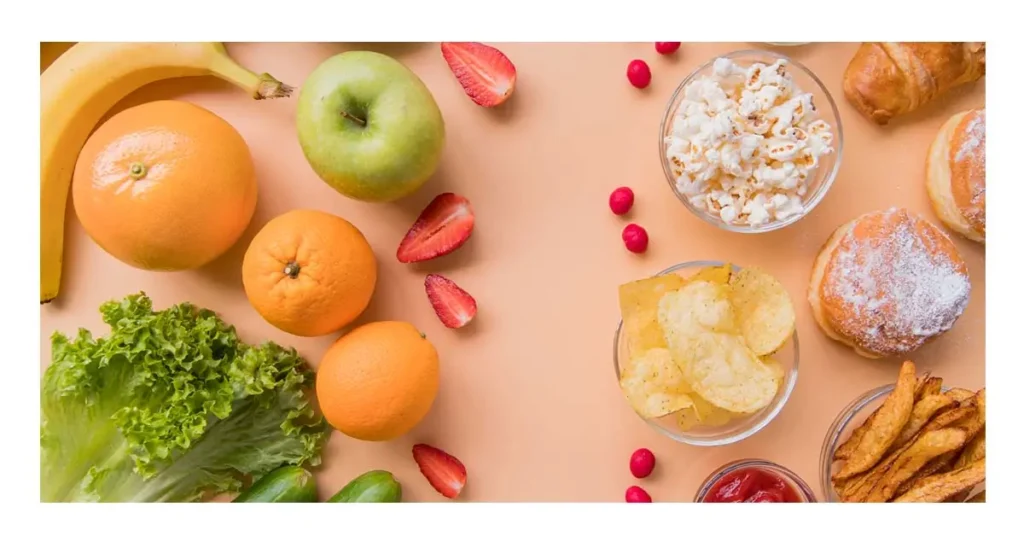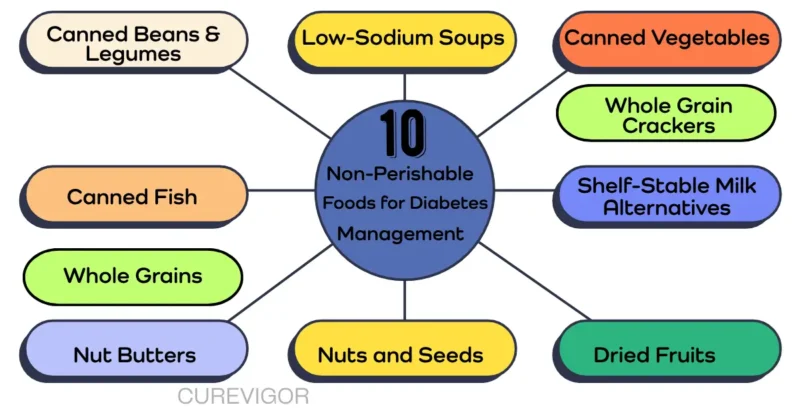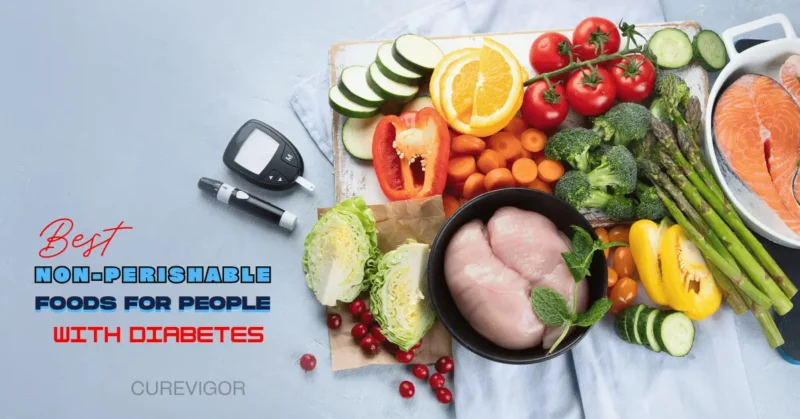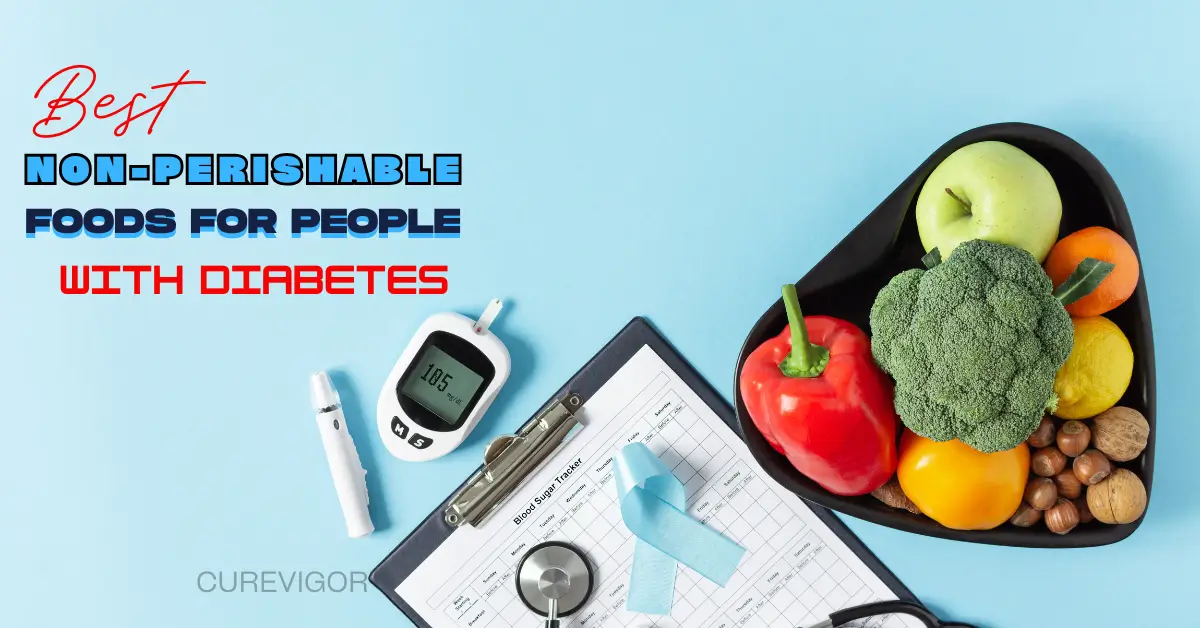Stock your pantry the smart way! Discover the 10 best non-perishable foods for diabetes, ranked by fiber, protein, and low-GI score. Essential guide & free checklist!
Thank you for reading this post, don't forget to subscribe!Medical Disclaimer: The basic nutritional information in this article should not be used in place of expert medical advice, diagnosis, or treatment.
Before making any dietary, medication, or lifestyle changes, or before discussing any medical concern, always get advice from a registered dietitian or other trained healthcare professional.
Why Non-Perishable Foods Matter for Diabetes Management
Managing diabetes requires careful attention to diet, and non-perishable foods can be a convenient and reliable option, especially during emergencies or when fresh produce isn’t available.

For people with diabetes, selecting non-perishable foods with a low glycemic index (GI), high fiber content, and minimal added sugars is crucial. Moreover, these foods provide essential nutrients for long-term health.
Foods with a lengthy shelf life that don’t need refrigeration are known as non-perishables.
Regardless of the appearance of your pantry, this comprehensive guide will help you manage your blood sugar levels by going over the best selections.
The Diabetes-Friendly Pantry Scorecard: Ranking Your Essentials
To help you make the best choices, we’ve created a Nutritional Value Scorecard based on key factors that impact blood sugar management: Fiber, Protein, and Glycemic Load (GL). Foods with higher scores offer superior blood sugar control.
| Non-Perishable Food | Fiber Score | Protein Score | Low-GI Score | Overall Rank | Why It Wins |
| Canned Beans/Legumes | *** | *** | *** | A+ | High in both protein and fiber for maximum satiety. |
| Canned Fish (e.g., Salmon) | * | *** | *** | A | Excellent protein and heart-healthy omega-3 fats. |
| Nuts and Seeds | *** | ** | *** | A | Healthy fats and fiber stabilize blood sugar spikes. |
| Whole Grains (e.g., Quinoa) | *** | ** | ** | B+ | Superior to refined grains; a backbone of a healthy diet. |
| Nut Butters (Unsweetened) | ** | ** | ** | B | Convenient source of healthy fats and protein. |
Methodology Note: The above scores are derived from standard USDA nutritional data and established Glycemic Index (GI)/Load (GL) values. High-scoring foods are prioritized for their combination of fibre, protein, and low blood sugar impact.
Top 10 Non-Perishable Foods for Diabetes Management

Here are the details on the essential foods for your pantry:
1. Canned Beans and Legumes (The Pantry Powerhouse)
Good sources of protein and fibre include canned beans and legumes, including chickpeas, black beans, and lentils. They work well in a range of recipes and have a naturally low glycemic index.
- Benefits: Protein-rich (muscle health), rich in fibre (digestion and blood sugar control), and a low glycemic index (slow, subtle rise in blood sugar).
- Usage: Add to salads, mix into soups, or blend to make a healthy bean dip.
2. Whole Grains
In contrast to refined carbohydrates, whole grains such as quinoa, brown rice, and oatmeal are higher in fibre and have a lower effect on blood sugar levels.
- Benefits: High in fibre (regulates blood sugar), a good source of vitamins and minerals, and a lower glycemic index.
- Usage: Use as a base for meals (rice bowls), add to soups, or enjoy oatmeal for a nutritious breakfast.
3. Canned Fish (Omega-3 Heroes)
High-quality protein and omega-3 fatty acids found in canned fish, such as salmon, tuna (packed in water), and sardines, are beneficial for heart health, a significant concern for diabetics.
- Benefits: High in heart-healthy, anti-inflammatory omega-3 fatty acids, high in protein, and doesn’t need to be refrigerated.
- Usage: Make sandwiches with whole-grain bread, add to salads for an extra protein boost, or enjoy with whole-grain crackers.
4. Nuts and Seeds
Nuts and seeds, including almonds, walnuts, chia seeds, and flaxseeds, are perfect snacks that provide healthy fats, protein, and fibre.
- Benefits: High in healthy monounsaturated and polyunsaturated fats (good for heart health), high in fibre and protein (control blood sugar and promote satiety), and convenient for snacking.
- Usage: Eat a handful as a quick snack, sprinkle on yogurt, or incorporate into baked goods.
5. Nut Butters (Unsweetened)
Nut butters such as almond butter and peanut butter (check the label for no added sugar) offer a nutritious and convenient option for spreading or dipping.
- Benefits: High in healthy fats and protein (maintains energy and satiety), and adaptable in a range of recipes.
- Usage: Spread on whole-grain bread, blend into smoothies, or use as a dip for fresh vegetables.
6. Canned Vegetables (Low-Sodium Focus)
Canned vegetables, like low-sodium tomatoes, green beans, and spinach, can be nutritious additions to meals when fresh produce is not available. Always rinse them to reduce sodium content.
- Benefits: Long shelf life, retains most nutrients when properly preserved, and is simple to incorporate into meals.
- Usage: Add to soups and stews, or serve as a quick side dish.
7. Low-Sodium Soups
Numerous low-sodium soup options are appropriate for diabetics, making them a quick and simple supper choice.
- Benefits: Convenient, wide variety of options and flavors, and easy to prepare.
- Usage: Enjoy as a main course, or use as a base for adding extra beans, whole grains, or canned vegetables.
8. Shelf-Stable Milk Alternatives (Unsweetened)
Unsweetened almond milk, soy milk, and oat milk are examples of shelf-stable substitutes that are often fortified with vitamins such as D and B12, and minerals like calcium.
- Benefits: Long shelf life without refrigeration, often fortified with essential nutrients, and provides lactose-free options.
- Usage: Use in cooking and baking, enjoy as a beverage, or pour over cereal or oatmeal.
9. Whole Grain Crackers
Whole-grain crackers can be a convenient snack or base for other toppings, providing fibre and sustained energy.
- Benefits: High in fibre (helps maintain stable blood sugar), easy to store, and versatile for various toppings.
- Usage: Quick snack on their own, paired with nut butter, or used with low-fat cheese.
10. Dried Fruits (In Strict Moderation)
While dried fruits should be consumed in moderation due to their concentrated sugar content, options like unsweetened dried berries, apricots, and apples can be part of a healthy diet.
- Benefits: Portable, rich in fiber and vitamins, and a source of natural sweetness.
Usage: Enjoy a tiny, measured portion as a quick snack, or mix into oatmeal for added flavor.
Creating a Balanced Diabetes Meal Plan with Non-Perishables

Combining different food groups is crucial to maintaining a balanced diet with non-perishable foods, as it ensures a diverse range of nutrients.
| Meal | Non-Perishable Components |
| Breakfast | Oatmeal topped with chia seeds and a handful of almonds. A glass of unsweetened almond milk. |
| Lunch | Canned chickpea salad (mixed with olive oil/vinegar). Whole grain crackers with unsweetened peanut butter. |
| Dinner | Quinoa mixed with canned salmon (drained) and canned low-sodium green beans. A side of low-sodium vegetable soup. |
| Snack | A measured portion of walnuts and a small amount of dried apricots. |
FAQs on Non-Perishable Foods for Diabetes
Q. What foods can you eat freely with diabetes?
Non-starchy vegetables, such as spinach, kale, broccoli, and bell peppers, are very low in calories and carbs but high in fiber and minerals, so people with diabetes can eat them in large quantities. Because it doesn’t considerably increase blood sugar, this fiber is essential.
Additionally, healthy fats like avocado and olive oil, as well as lean proteins like skinless chicken breast and plain tofu, are great foundation foods that encourage fullness without raising blood sugar levels like carbohydrates do.
Meal planning is easy and tasty when you center your plate around these products.
Q. What is the best thing to fight diabetes?
A regular, multifaceted healthy lifestyle is the most effective way to combat diabetes, not just one food or medication.
A balanced diet with low-GI foods, whole grains, and fiber, along with at least 150 minutes of moderate exercise each week and consistent blood sugar monitoring with prescribed medications, is key to maintaining health.
The entire approach aids in weight management, insulin sensitivity improvement, and the avoidance of the chronic difficulties that characterize the battle against diabetes.
Q. What to avoid in diabetes?
You should rigorously limit foods that contain simple, highly processed carbs and added sugars to keep your blood sugar stable.
Because they cause sharp, rapid rises in blood sugar, this includes sugary beverages (soda, sweetened tea), white bread, white rice, candies, and most commercial baked goods.
Limiting foods high in trans and saturated fats, such as fatty meats and fried foods, is also a good idea because these fats raise the risk of heart disease, which is a serious worry for diabetics.
The best strategies for maintaining a healthy diet are to avoid processed foods and to read labels carefully for hidden sugars.
Q. What Foods Will Lower Blood Sugar Quickly?
While no food is a substitute for medical intervention, certain items can help stabilize and gently lower blood sugar.
Cinnamon (improves insulin sensitivity), Vinegar (taken before meals to lessen blood sugar rises), Green leafy vegetables, and Chia seeds (due to high fiber content).
Q. What should diabetics drink first thing in the morning?
A large glass of plain water is the greatest option for a diabetic to consume as soon as they wake up. Hydration helps the kidneys remove excess glucose and is essential for overall health.
If you need something a little more substantial, unsweetened tea or coffee will do as long as you don’t add sugar or flavoring syrups.
A glass of unsweetened, shelf-stable milk substitute (such as almond or soy milk) is a good option because it provides fluids and a little protein or fat without raising your blood sugar in the morning.
Conclusion on Non-Perishable Foods for Diabetes
Choosing the right non-perishable foods can make managing diabetes more convenient without compromising on nutrition.
By incorporating a variety of nutrient-dense, low-glycemic, and fiber-rich foods, you can maintain a balanced and healthy diet even when fresh options are limited.
Ready to stock your kitchen with confidence?
Download our free, printable “Diabetes-Friendly Emergency Pantry Checklist” to ensure you always have the best non-perishables on hand!
Read more Health and Wellness Tips.
You may like to read:

